Themed collection Water splitting and photocatalysis

Themed issue on water splitting and photocatalysis
Guest editors Shannon Boettcher, Thomas Mallouk and Frank Osterloh introduce this Journal of Materials Chemistry A themed issue on water splitting and photocatalysis.

J. Mater. Chem. A, 2016,4, 2764-2765
https://doi.org/10.1039/C6TA90014C
Solar-powered electrochemical energy storage: an alternative to solar fuels
The solar-powered electrochemical energy storage strategy integrates the solar energy conversion, storage and distribution functions into a single device.
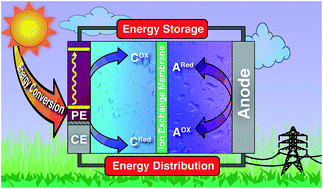
J. Mater. Chem. A, 2016,4, 2766-2782
https://doi.org/10.1039/C5TA06950E
Tantalum (oxy)nitride based photoanodes for solar-driven water oxidation
The recent development of tantalum (oxy)nitride based photoanodes is summarized and their future trends are also discussed.
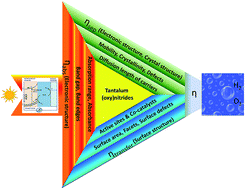
J. Mater. Chem. A, 2016,4, 2783-2800
https://doi.org/10.1039/C5TA07057K
Artificial photosynthesis using metal/nonmetal-nitride semiconductors: current status, prospects, and challenges
Artificial photosynthesis, i.e. the chemical transformation of sunlight, water and carbon dioxide into high-energy-rich fuels is one of the key sustainable energy technologies to enable a carbon-free, storable and renewable source of energy.
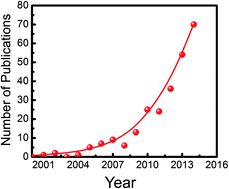
J. Mater. Chem. A, 2016,4, 2801-2820
https://doi.org/10.1039/C5TA07364B
Liquid contacting as a method to study photovoltaic properties of PbS quantum dot solids
Semiconductor/liquid junctions can help better understand the photovoltage “potential” of PbS QD solids.

J. Mater. Chem. A, 2016,4, 9009-9013
https://doi.org/10.1039/C6TA02328B
An electrochemical method to enhance the performance of metal oxides for photoelectrochemical water oxidation
Oxygen-deficient metal oxides prepared by electrochemical method show substantially enhanced photoactivity due to improved efficiency of charge separation and injection.
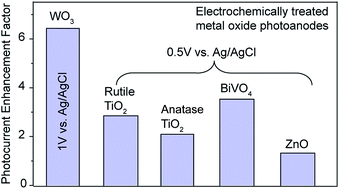
J. Mater. Chem. A, 2016,4, 2849-2855
https://doi.org/10.1039/C5TA10477G
Increased activity in hydrogen evolution electrocatalysis for partial anionic substitution in cobalt oxysulfide nanoparticles
Metastable CoOxSy electrocatalysts for the hydrogen evolution reaction were prepared by anion exchange. Lightly doped CoOxS0.18 is 2–3 times more active than either end-member of the substitution series due to optimized H adsorption energy.
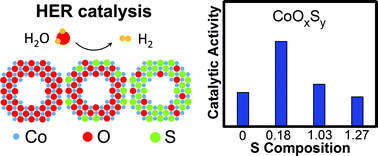
J. Mater. Chem. A, 2016,4, 2842-2848
https://doi.org/10.1039/C5TA08706F
Hyperbranched potassium lanthanum titanate perovskite photocatalysts for hydrogen generation
A novel titanate perovskite with orthogonal hierarchical nanostructure morphology was evaluated for the first time as a photocatalyst for hydrogen production from water.
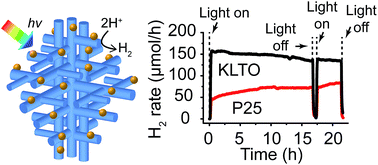
J. Mater. Chem. A, 2016,4, 2837-2841
https://doi.org/10.1039/C5TA07424J
Remarkable stability of unmodified GaAs photocathodes during hydrogen evolution in acidic electrolyte
GaAs photocathodes are intrinsically stabilized by surface As during hydrogen evolution at −15 mA cm−2 in acid; etching at <0.5 nm h−1 while maintaining performance.
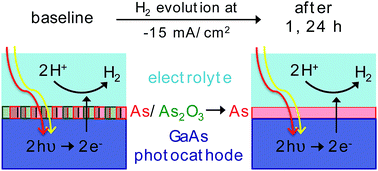
J. Mater. Chem. A, 2016,4, 2831-2836
https://doi.org/10.1039/C5TA07648J
Atomic layer stack deposition-annealing synthesis of CuWO4
Stack deposition-annealing (SDA) synthesis of photocatalytic CuWO4 thin films via sequential ALD of WO3/CuO and post-ALD annealing.
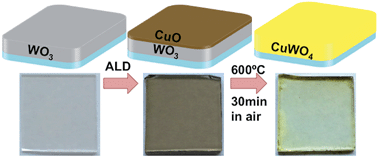
J. Mater. Chem. A, 2016,4, 2826-2830
https://doi.org/10.1039/C5TA06899A
A facile nonpolar organic solution process of a nanostructured hematite photoanode with high efficiency and stability for water splitting
A facile nonpolar organic solution approach has been developed for a high performance hematite photoanode at a low sintering temperature (550 °C).
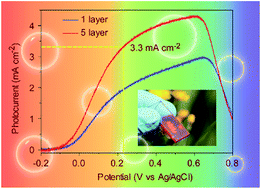
J. Mater. Chem. A, 2016,4, 2821-2825
https://doi.org/10.1039/C5TA06439B
Revealing the semiconductor–catalyst interface in buried platinum black silicon photocathodes
Burying platinum black silicon photocathodes provides an atomically clean Pt catalyst/Si interface free of oxide or other phases.
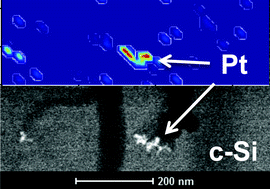
J. Mater. Chem. A, 2016,4, 8123-8129
https://doi.org/10.1039/C6TA02505F
Solar fuel photoanodes prepared by inkjet printing of copper vanadates
Widespread deployment of solar fuel generators requires the development of efficient and scalable functional materials, especially for photoelectrocatalysis of the oxygen evolution reaction.
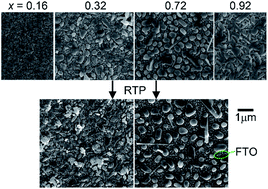
J. Mater. Chem. A, 2016,4, 7483-7494
https://doi.org/10.1039/C6TA01252C
New materials for the light-induced hydrogen evolution reaction from the Cu–Si–Ti–O system
Ti:CuSiO3 and Si:Cu3TiOx are identified as promising photocathode materials with improved stability and high photocurrent densities.
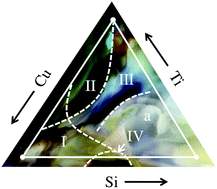
J. Mater. Chem. A, 2016,4, 3148-3152
https://doi.org/10.1039/C5TA10186G
Decoration of ultra-long carbon nanotubes with Cu2O nanocrystals: a hybrid platform for enhanced photoelectrochemical CO2 reduction
Photoelectrochemical reduction of CO2 to form useful chemicals is an increasingly studied avenue for harnessing and storing solar energy.
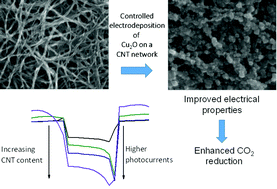
J. Mater. Chem. A, 2016,4, 3139-3147
https://doi.org/10.1039/C5TA10457B
Highly efficient rutile TiO2 photocatalysts with single Cu(II) and Fe(III) surface catalytic sites
Single Cu(II) and Fe(III) surface catalytic sites dramatically enhance the activity of rutile TiO2 in photocatalytic degradation of 4-chlorophenol.
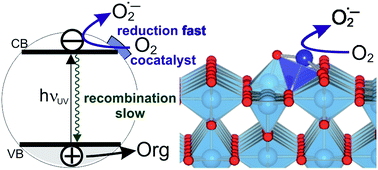
J. Mater. Chem. A, 2016,4, 3127-3138
https://doi.org/10.1039/C5TA07036H
Electronic structure, photovoltage, and photocatalytic hydrogen evolution with p-CuBi2O4 nanocrystals
As a visible light active p-type semiconductor, CuBi2O4 is of interest as a photocatalyst for the generation of hydrogen fuel from water.
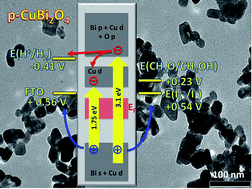
J. Mater. Chem. A, 2016,4, 2936-2942
https://doi.org/10.1039/C5TA07040F
Utilizing modeling, experiments, and statistics for the analysis of water-splitting photoelectrodes
A multi-physics model of a planar water-splitting photoelectrode was developed, validated, and used to identify and quantify the most significant materials-related bottlenecks in photoelectrochemical device performance.
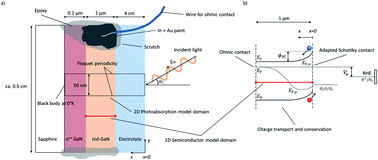
J. Mater. Chem. A, 2016,4, 3100-3114
https://doi.org/10.1039/C5TA07328F
CuNb1−xTaxO3 (x ≤ 0.25) solid solutions: impact of Ta(V) substitution and Cu(I) deficiency on their structure, photocatalytic, and photoelectrochemical properties
Investigation of CuNb1−xTaxO3 has led to new insights into the visible-light photocurrents and photocatalytic activities of solid solutions.
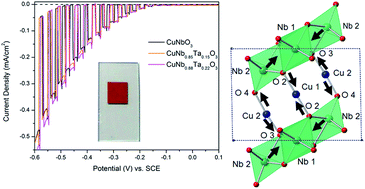
J. Mater. Chem. A, 2016,4, 3115-3126
https://doi.org/10.1039/C5TA06609C
Systematic comparison of different dopants in thin film hematite (α-Fe2O3) photoanodes for solar water splitting
Thin (~50 nm) film hematite photoanodes doped with different dopants at a concentration of 1 cation% display internal solar to chemical (ISTC) conversion efficiency in the following order: Sn > Nb > Si > Pt > Zr > Ti > Zn > Ni > Mn.
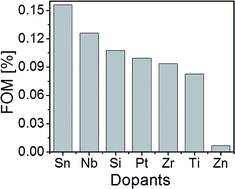
J. Mater. Chem. A, 2016,4, 3091-3099
https://doi.org/10.1039/C5TA07095C
Optimized immobilization of ZnO:Co electrocatalysts realizes 5% efficiency in photo-assisted splitting of water
Organic solvents with varied electrophoretic mobility have been employed for deposition of nanocrystalline ZnO:Co particles onto fluorinated tin oxide supports.

J. Mater. Chem. A, 2016,4, 3082-3090
https://doi.org/10.1039/C5TA07329D
Heteroepitaxial hematite photoanodes as a model system for solar water splitting
Heteroepitaxial hematite thin film photoanodes were fabricated, characterized, and shown to be a model system for fundamental studies into solar water splitting.
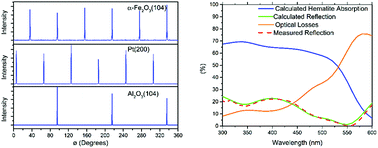
J. Mater. Chem. A, 2016,4, 3052-3060
https://doi.org/10.1039/C5TA07094E
Benchmarking nanoparticulate metal oxide electrocatalysts for the alkaline water oxidation reaction
16 crystalline metal oxide nanoparticulate systems are adhered to an electrode surface using a conventional drop-casting method and measured for their activity for the oxygen evolution reaction.
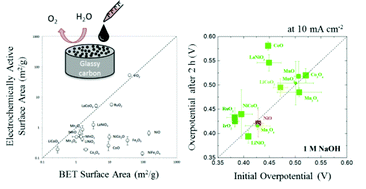
J. Mater. Chem. A, 2016,4, 3068-3076
https://doi.org/10.1039/C5TA07586F
Separation of light confinement and absorption sites for enhancing solar water splitting
More than 30% enhancement in photocurrent is achieved by separating light confinement and absorption sites within the solar cell.

J. Mater. Chem. A, 2016,4, 3043-3051
https://doi.org/10.1039/C5TA06972F
Colloidally-synthesized cobalt molybdenum nanoparticles as active and stable electrocatalysts for the hydrogen evolution reaction under alkaline conditions
Colloidal nanoparticles of a cobalt–molybdenum alloy were synthesized and found to be active electrocatalysts for the hydrogen evolution reaction in alkaline aqueous solutions.
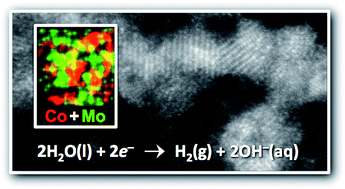
J. Mater. Chem. A, 2016,4, 3077-3081
https://doi.org/10.1039/C5TA07055D
A silver-inserted zinc rhodium oxide and bismuth vanadium oxide heterojunction photocatalyst for overall pure-water splitting under red light
We have prepared a solid-state heterojunction photocatalyst, in which zinc rhodium oxide (ZnRh2O4) and bismuth vanadium oxide (Bi4V2O11) as hydrogen (H2) and oxygen (O2) evolution photocatalysts, respectively, were connected with silver (Ag, ZnRh2O4/Ag/Bi4V2O11).
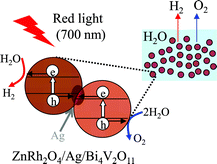
J. Mater. Chem. A, 2016,4, 3061-3067
https://doi.org/10.1039/C5TA08468G
Facile growth of porous Fe2V4O13 films for photoelectrochemical water oxidation
Porous n-type Fe2V4O13 films were prepared by a simplified successive ion layer adsorption method and the photogenerated holes in the films can be efficiently utilized to oxidize water to oxygen.
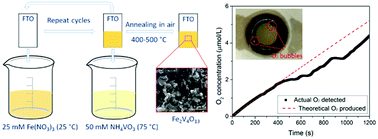
J. Mater. Chem. A, 2016,4, 3034-3042
https://doi.org/10.1039/C5TA07877F
Alkali metals incorporated ordered mesoporous tantalum oxide with enhanced photocatalytic activity for water splitting
We present a soft-templating synthesis of amorphous ordered mesoporous tantalates with incorporated alkali earth metals for photocatalytic water splitting.

J. Mater. Chem. A, 2016,4, 3007-3017
https://doi.org/10.1039/C5TA07086D
Gallium arsenide phosphide grown by close-spaced vapor transport from mixed powder sources for low-cost III–V photovoltaic and photoelectrochemical devices
Close-spaced vapor transport provides GaAs1−xPx with controlled composition and competitive electronic properties.

J. Mater. Chem. A, 2016,4, 2909-2918
https://doi.org/10.1039/C5TA06900A
Some aspects of the charge transfer dynamics in nanostructured WO3 films
Charge transfer dynamics in WO3 photoelectrodes: hydroxyl radicals are the primary water oxidation intermediates generated via valence band hole injection.
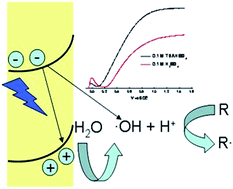
J. Mater. Chem. A, 2016,4, 2995-3006
https://doi.org/10.1039/C5TA06887H
A new method for the synthesis of β-cyano substituted porphyrins and their use as sensitizers in photoelectrochemical devices
The properties of cyanoporphyrins make them good candidates for sensitizers in photoelectrosynthetic cells. A new procedure for preparation of these has been developed and two cyanoporphyrins have been evaluated as sensitizers for photoanodes.
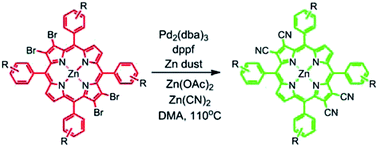
J. Mater. Chem. A, 2016,4, 2976-2985
https://doi.org/10.1039/C5TA07226C
Kinetic analysis of photoelectrochemical water oxidation by mesostructured Co-Pi/α-Fe2O3 photoanodes
Kinetics measurements are used to clarify the effect of Co-Pi on solar water splitting by Co-Pi/α-Fe2O3 composite photoanodes.
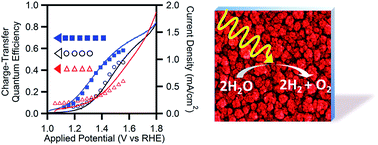
J. Mater. Chem. A, 2016,4, 2986-2994
https://doi.org/10.1039/C5TA06978E
An aqueous, organic dye derivatized SnO2/TiO2 core/shell photoanode
Visible light driven water splitting in a dye-sensitized photoelectrochemical cell (DSPEC) based on a phosphonic acid-derivatized donor–π–acceptor (D–π–A) organic dye (P–A–π–D) is described with the dye anchored to an FTO|SnO2/TiO2 core/shell photoanode in a pH 7 phosphate buffer solution.
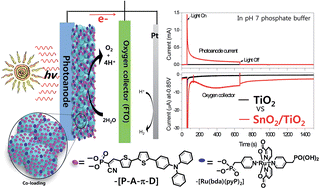
J. Mater. Chem. A, 2016,4, 2969-2975
https://doi.org/10.1039/C5TA06678F
A simplified theoretical guideline for overall water splitting using photocatalyst particles
A guideline to achieve efficient photocatalytic water splitting is presented using theoretical simulations of particulate semiconductors decorated with metal particles.
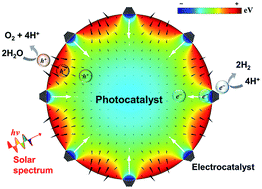
J. Mater. Chem. A, 2016,4, 2894-2908
https://doi.org/10.1039/C5TA06983A
Flux-mediated doping of SrTiO3 photocatalysts for efficient overall water splitting
SrTiO3 doped with Al and treated with SrCl2 flux showed an apparent quantum efficiency of 30% at 360 nm in the photocatalytic overall water splitting reaction.
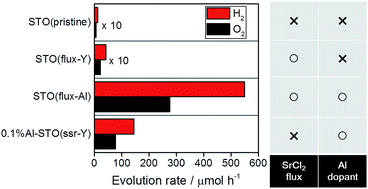
J. Mater. Chem. A, 2016,4, 3027-3033
https://doi.org/10.1039/C5TA04843E
Improving charge collection with delafossite photocathodes: a host–guest CuAlO2/CuFeO2 approach
p-Type delafossite CuFeO2 has recently been reported as a promising candidate for direct photoelectrochemical solar water reduction in alkaline conditions.
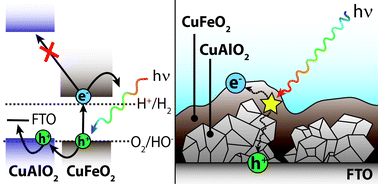
J. Mater. Chem. A, 2016,4, 3018-3026
https://doi.org/10.1039/C5TA06336A
Improving the stability and selectivity for the oxygen-evolution reaction on semiconducting WO3 photoelectrodes with a solid-state FeOOH catalyst
WO3 electrodes were synthesized via a sol–gel route followed by the photoelectrochemical deposition of a solid state FeOOH oxygen-evolution catalyst (OEC) to observe its effects on electrode stability and selectivity towards the oxygen evolution reaction (OER).
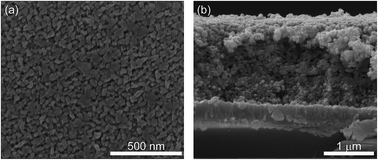
J. Mater. Chem. A, 2016,4, 2960-2968
https://doi.org/10.1039/C5TA04747A
Periodate – an alternative oxidant for testing potential water oxidation catalysts
Periodate is used as an alternative oxidant in the rapid screening of new potential water oxidation catalyst material powders.
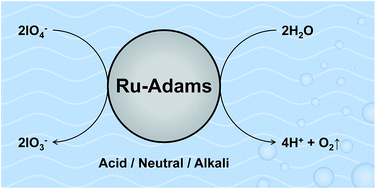
J. Mater. Chem. A, 2016,4, 2863-2872
https://doi.org/10.1039/C5TA06510K
Strongly oxidizing perylene-3,4-dicarboximides for use in water oxidation photoelectrochemical cells
Perylene-3,4-dicarboximide (PMI) based chromophores are explored for use in photoelectrochemical cells (PECs) for solar fuels generation.

J. Mater. Chem. A, 2016,4, 2880-2893
https://doi.org/10.1039/C5TA05790F
Ferroelastic domains improve photochemical reactivity: a comparative study of monoclinic and tetragonal (Bi1−0.5xNa0.5x)(V1−xMox)O4 ceramics
When the reactivities of crystals of the same orientation of (Bi1−0.5xNa0.5x)(V1−xMox)O4, with x = 0.05 and x = 0.175, are compared, the monoclinic (x = 0.05) sample is more reactive.
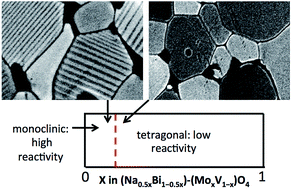
J. Mater. Chem. A, 2016,4, 2951-2959
https://doi.org/10.1039/C5TA05551B
In situ surface alkalinized g-C3N4 toward enhancement of photocatalytic H2 evolution under visible-light irradiation
An in situ surface alkalization over g-C3N4 achieves 14-fold enhancement in photocatalytic H2 evolution.
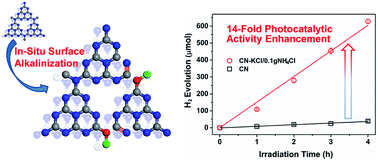
J. Mater. Chem. A, 2016,4, 2943-2950
https://doi.org/10.1039/C5TA05128B
Synthesis and characterization of (Ga1−xZnx)(N1−xOx) nanocrystals with a wide range of compositions
(Ga1−xZnx)(N1−xOx) nanocrystals with a wide range of compositions and band gaps are formed by topotactic nucleation at ZnO/ZnGa2O4 interfaces.
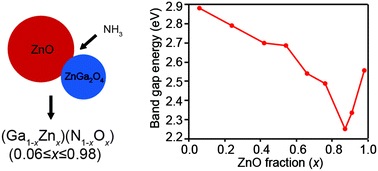
J. Mater. Chem. A, 2016,4, 2927-2935
https://doi.org/10.1039/C5TA04314J
Photocharged BiVO4 photoanodes for improved solar water splitting
Long exposure of BiVO4 photoanodes to light under open circuit conditions (photocharging) results in the record high current densities for undoped and uncatalyzed BiVO4.
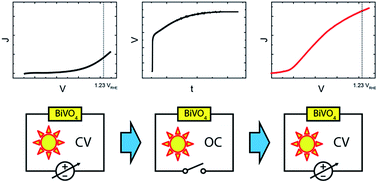
J. Mater. Chem. A, 2016,4, 2919-2926
https://doi.org/10.1039/C5TA04716A
Charge transfer processes at the semiconductor/electrolyte interface for solar fuel production: insight from impedance spectroscopy
Low frequency capacitance measurements allow decoupling direct hole transfer from the valence band and indirect hole transfer from surface states.
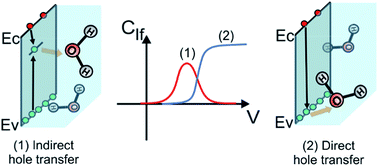
J. Mater. Chem. A, 2016,4, 2873-2879
https://doi.org/10.1039/C5TA03210E
Ligand removal from CdS quantum dots for enhanced photocatalytic H2 generation in pH neutral water
Photocatalytic hydrogen evolution activity of CdS QDs is 175 times higher in pH neutral water when surface capping ligands are removed.
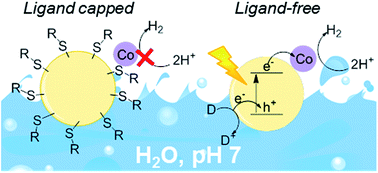
J. Mater. Chem. A, 2016,4, 2856-2862
https://doi.org/10.1039/C5TA04136H
Correction: Optimized immobilization of ZnO:Co electrocatalysts realizes 5% efficiency in photo-assisted splitting of water
J. Mater. Chem. A, 2016,4, 3154-3154
https://doi.org/10.1039/C6TA90030E
Correction: Improving the stability and selectivity for the oxygen-evolution reaction on semiconducting WO3 photoelectrodes with a solid-state FeOOH catalyst
J. Mater. Chem. A, 2016,4, 3153-3153
https://doi.org/10.1039/C5TA90202A
About this collection
Upwards trends in population growth and natural resource consumption require a more sustainable approach to the production and processing of energy, water, food, and chemicals. In theory, most of aspects of human society can be powered by the sunlight received on the surface of Earth- what’s missing is a cheap and reliable technology to harness this abundant energy and convert it into fuels.
This themed issue, guest edited by Thomas E. Mallouk (Pennsylvania State University, USA), Shannon W. Boettcher (University of Oregon, USA), and Journal of Materials Chemistry A Associate Editor Frank E. Osterloh (University of California, Davis, USA), puts a spotlight on recent scientific developments in the area of solar-powered fuel generation, water and air purification, and chemicals processing, and highlights remarkable contributions made by the leading scientists in this important research area.